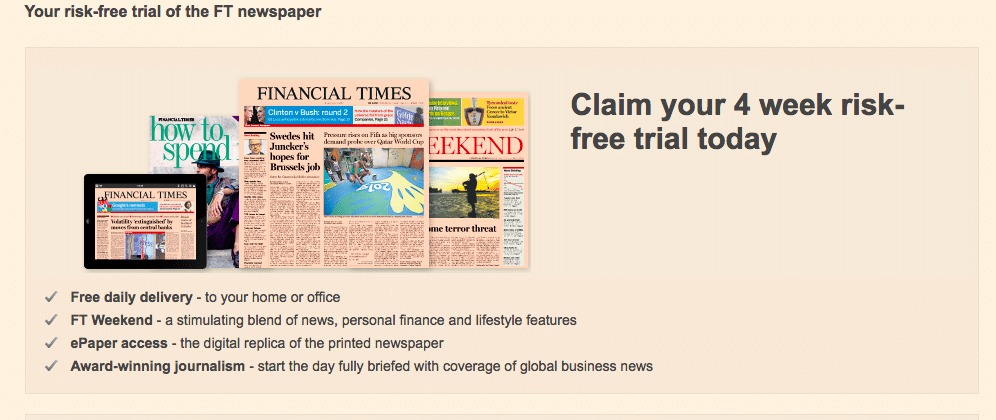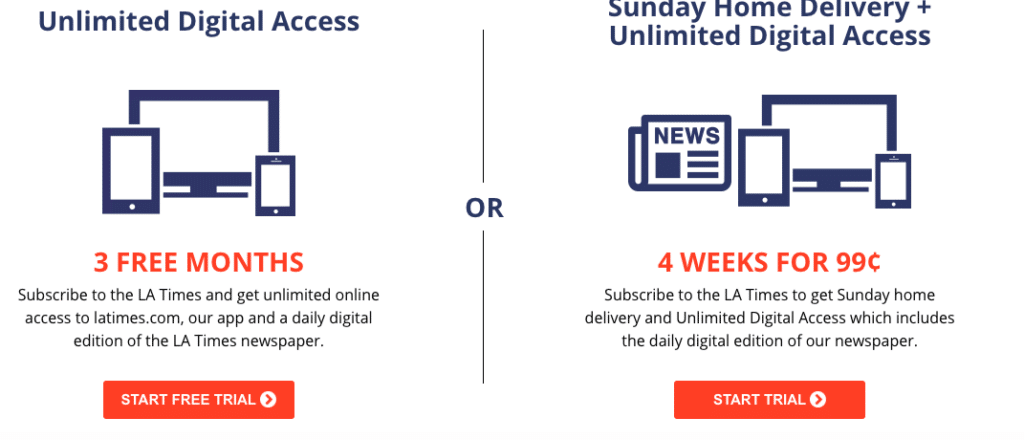 While publishers should seize on the opportunities offered by email marketing, they should not view email — or any single approach — as the magic bullet to gaining subscribers. Wherever possible, news organizations should be using multiple touch points to connect with prospective subscribers, both on and offline. Email campaigns, while effective, rely on having a list, which takes time to assemble. Also, emails can only be sent to a known universe of prospects, whereas other marketing channels expand the audience potential. Multiple approaches can complement each other. These include online calls to action, refer-a-friend programs, dynamic meters, free and low-cost trials, and partnerships.
While publishers should seize on the opportunities offered by email marketing, they should not view email — or any single approach — as the magic bullet to gaining subscribers. Wherever possible, news organizations should be using multiple touch points to connect with prospective subscribers, both on and offline. Email campaigns, while effective, rely on having a list, which takes time to assemble. Also, emails can only be sent to a known universe of prospects, whereas other marketing channels expand the audience potential. Multiple approaches can complement each other. These include online calls to action, refer-a-friend programs, dynamic meters, free and low-cost trials, and partnerships.
Online calls to action
Surfacing a subscription offer when readers are engaged with content they find compelling can be an effective tactic to gain subscribers. This type of digital marketing requires a command of tracking and analytics to determine the content that is most valuable to particular readers, and therefore most effective in getting them to pay.
Pop-ups that convert: The Washington Post
A pop-up ad for The Washington Post’s Sunday home delivery features several different elements that highlight the benefits of subscribing. If a reader tries to leave the order landing page without subscribing, an attention-getting ad pops up asking the reader not to leave yet. This pop-up emphasizes that it is cheap to subscribe and breaks down the rate to a low weekly cost.
The bottom of the ad reinforces the Post’s value proposition by reminding the reader that the Post is “Award-winning,” “Top” and “Best.”

While much attention is being paid to digital subscriptions and engagement, API research shows there is still a sizable group of (generally older) subscribers whose preferred format is print. They should not be ignored, even as the industry shifts its focus to digital.
A seasonal incentive: The Journal Sentinel
The annual calendar can inspire tactics to motivate subscribers. For example, the Journal Sentinel’s pop-up offers a seasonal discount, which creates a sense of urgency. Overall, the copy and graphics of this ad convey the need to connect over the summer, and more specifically, connect digitally to the Journal Sentinel. This copy, combined with the beachy graphics, convey that readers can be on vacation and still connected to the news that is important to them.

News that citizens need to have: The San Francisco Chronicle
This Chronicle ad reminds voters that it can help them make informed decisions in the coming election. In contrast to the cheerful colors used by the Journal Sentinel in a summer pop-up, the Chronicle text is stark and bold, underscoring the weighty responsibility of voters and the value of its coverage.

Refer-a-friend programs
Frequently, readers are exposed to a publication through their friends and family. They might borrow print copies, forward articles online or share content through their social media networks. Refer-a-friend programs are a great way to encourage and reward these organic interactions.
Enabling shared subscriptions: Las Vegas Review-Journal
News organizations may tout shared access as one of the benefits of a subscription right on the offer page. The Las Vegas Review-Journal allows up to four people in each household to share a subscription, adding to its value.
Publishers also benefit, because more people read their digital content, which has been “endorsed” by a subscriber in their own family. As online usage and engagement is tracked, organizations can learn which types of content are most appealing to these additional readers.

Bonus digital subscriptions: The Washington Post
While similar to allowing family members to share, this tactic goes a step further by enabling new “premium” subscribers to name an additional new digital subscriber at no added cost. This approach is another way for news organizations to expand their audience, while learning more about reader interests and behavior through testing and measurement.

Gift offers to attract paying readers: The New York Times
Readers may be willing to pay after they have enjoyed a gift subscription. The New York Times makes three choices available, mirroring those of a regular subscription, which adds some familiarity for the gifter. There is also a 50 percent discount offered for the gift subscription, which adds appeal. The value proposition of the Times is very clear in the heading, which is aimed at readers who are drawn to the paper’s substance and authority: “Give the Facts, Give the World, Give The Times.”

Online stores that reward shoppers: San Francisco Chronicle
Not only can readers subscribe at the San Francisco Chronicle’s online store — choosing among digital, Sunday only, and seven-day delivery options — they can also browse an array of items that may build loyalty and reinforce a sense of community. In October 2018, these included T-shirts, commemorative newspaper covers (celebrating sports teams), guides to wine and restaurants, and more.

Free or low-cost trials
Publishers can experiment with offering free or low-cost trials to readers, allowing them to experience the full benefits of being a paid subscriber, and upselling them at the end of the trial period.
Since buying a subscription is a long-term, and often recurring, financial commitment, there is more at stake for users than if they were purchasing a single item. Offering free or low-cost trials is an easy way for the reader to experience the subscription before making that decision. During such trials, it is important to track customers’ usage, encourage deeper engagement and communicate the benefits of subscribing.
Reducing risk to gain subscribers: The Baltimore Sun, the Financial Times and the Los Angeles Times
These organizations emphasize the low risk associated with a trial subscription by offering a free period at the start and easy options to cancel. The Sun communicates the low risk with its “Cancel Anytime” callout, and the FT refers to its trial as “risk-free” throughout the ad copy. These features give prospective subscribers some security and peace of mind that may help overcome hesitation to pay.
It is crucial to communicate the value of the content and subscription during the trial period. An email welcome series that explains the benefits of subscribing can be tailored for trial subscribers. It is also helpful to track trial subscribers’ online activity to see which content is engaging them most. Knowing which types of content convert readers into subscribers — and highlighting it — will also help push trial subscriptions through the digital sales funnel. Trials are also a great way to get more people to buy annual subscriptions, which generally renew at a higher rate than monthly subscriptions.
The length of the trial period can vary and should be tested to find what is most effective for the specific publication. The differences can be as subtle as choosing whether to use the word “weeks” or “months” in describing the length of time for a trial offer. In the examples below, consider how three publishers chose to highlight different lengths of time in the ads for their trials.



Subscriptions as a workplace perk: The Iowa Falls Times Citizen
 The Iowa Falls Times Citizen is pioneering an approach that has proven valuable both for the news organization and the local businesses it partners with. The paper offers group subscriptions at a discounted rate to local advertisers, which they can buy for their employees. As part of the package, the Times Citizen runs full-page ads featuring testimonials from advertisers’ employees about the paper.
The Iowa Falls Times Citizen is pioneering an approach that has proven valuable both for the news organization and the local businesses it partners with. The paper offers group subscriptions at a discounted rate to local advertisers, which they can buy for their employees. As part of the package, the Times Citizen runs full-page ads featuring testimonials from advertisers’ employees about the paper.
This arrangement gives the Times Citizen an added source of paid subscribers, and may result in less churn than more traditional partnership subscriptions, because subscribers see it as an employment perk. Local employers, which include banks, an auto center and a vision clinic, only pay once a year, which acts as another brake on attrition.
A cross-border alliance: The Globe and Mail and The New York Times
Globe and Mail readers who click through the “subscribe” call to action land on a page that offers a subscription to The New York Times as a compliment to the Globe and Mail, as its official Canadian distributor. This arrangement benefits both news organizations. The Globe and Mail gains credibility and trust through its close alliance with the Times. And the Times gets the benefits of having its brand supported by Canada’s preeminent news outlet.

Additional resources
* * *
The Reader Revenue Toolkit will continue to grow over time as more resources are added. As organizations continue to find innovative ways to get more and more of their revenue directly from readers, we will be surfacing their examples. Question you need answered? Something missing? Are your own reader revenue initiatives and projects proving successful and you want to share? Reach out to readerrevenue@pressinstitute.org, or sign up to receive updates as new resources are added to the toolkit.
The post Beyond email: Other tactics to drive users to subscription offers appeared first on American Press Institute.
from American Press Institute https://ift.tt/2DggRuL
 Cost-cutting move comes as GM posts strong third quarter.
Cost-cutting move comes as GM posts strong third quarter.

 Influence from the Ram 1500 is obvious.
Influence from the Ram 1500 is obvious.
 This, along with plenty of other manufacturers tease reveals for LA.
This, along with plenty of other manufacturers tease reveals for LA.
 Cadillac's sport coupe is a real shining star.
Cadillac's sport coupe is a real shining star.
 Mazda's automotive misfits helped spawn brand's most popular vehicles
Mazda's automotive misfits helped spawn brand's most popular vehicles
 With 536 horsepower, this widebody Golf R is ready for the track.
With 536 horsepower, this widebody Golf R is ready for the track.
 You do get a white leather interior though.
You do get a white leather interior though.
 It might not be as simple as it seems.
It might not be as simple as it seems.
 Solar systems would supplement ICE, hybrids and full electric vehicles
Solar systems would supplement ICE, hybrids and full electric vehicles
 Donckerwolke is famous for designing the Lamborghini Murciélago and others.
Donckerwolke is famous for designing the Lamborghini Murciélago and others.
 2016-2017 model year M cars could experience "loss of propulsion."
2016-2017 model year M cars could experience "loss of propulsion."
 The first of Classic Recreations' line of classic muscle-era Mustangs
The first of Classic Recreations' line of classic muscle-era Mustangs
 These Halloween deals are scary good.
These Halloween deals are scary good.
 'Bullitt' or Steve McQueen fandom isn't necessary. This Mustang is perfection.
'Bullitt' or Steve McQueen fandom isn't necessary. This Mustang is perfection.
 Two words: pickup trucks.
Two words: pickup trucks.
 Tesla showed a profit, but battery partner's costs were driven way up.
Tesla showed a profit, but battery partner's costs were driven way up.
 It's an expansion of driverless tests company has been doing in Arizona.
It's an expansion of driverless tests company has been doing in Arizona.
 While publishers should seize on the opportunities offered by email marketing, they should not view email — or any single approach — as the magic bullet to gaining subscribers. Wherever possible, news organizations should be using multiple touch points to connect with prospective subscribers, both on and offline.
While publishers should seize on the opportunities offered by email marketing, they should not view email — or any single approach — as the magic bullet to gaining subscribers. Wherever possible, news organizations should be using multiple touch points to connect with prospective subscribers, both on and offline. 











 It has the 1,000-horsepower Hellephant engine and wicked custom touches.
It has the 1,000-horsepower Hellephant engine and wicked custom touches.
 Supercharged 426 Hemi legitimately makes the Demon engine seem weak.
Supercharged 426 Hemi legitimately makes the Demon engine seem weak.
 Looking to bring some shine back to your ride?
Looking to bring some shine back to your ride?
 Some who survived last week's layoffs reportedly will be furloughed
Some who survived last week's layoffs reportedly will be furloughed
 It goes 0-60 mph in 4.1 seconds.
It goes 0-60 mph in 4.1 seconds.
 The car was built by SpeedKore Performance.
The car was built by SpeedKore Performance.
 Related to the BMW Z4, it'll go on sale in the first half of 2019
Related to the BMW Z4, it'll go on sale in the first half of 2019
 The Telluride SUVs are equipped with remote reservoir shocks.
The Telluride SUVs are equipped with remote reservoir shocks.
 It's called Seaker, and it's lovely.
It's called Seaker, and it's lovely.
 It's old on the outside, new on the inside.
It's old on the outside, new on the inside.
 It gets upgrades similar to the Elantra Sport trim.
It gets upgrades similar to the Elantra Sport trim.
 The Pie Pro is a robotic oven mounted in a hydrogen Tundra's bed.
The Pie Pro is a robotic oven mounted in a hydrogen Tundra's bed.
 Expect a continuous stream of aftermarket parts for Hyundai sport models.
Expect a continuous stream of aftermarket parts for Hyundai sport models.
 It's a cross between Honda's Ridgeline truck and its Pioneer 1000 side-by-side.
It's a cross between Honda's Ridgeline truck and its Pioneer 1000 side-by-side.
 Schmidt Peterson will keep a car ready for paralyzed driver's return
Schmidt Peterson will keep a car ready for paralyzed driver's return
 Added strength, clearance and rigidity for off-road enthusiasts.
Added strength, clearance and rigidity for off-road enthusiasts.
 GM says it's a marker for future electric product development.
GM says it's a marker for future electric product development.